When you’re in the market for a stick welder, selecting the right model can dramatically enhance your welding efficiency and quality. In recent years, the advancements in stick welder technology have led to a wider array of choices, which, while beneficial, can also complicate your purchasing decision. To make an informed choice, consider these crucial factors:
- Input Voltage: Consider the input voltage when choosing a stick Arc welder. Single-phase (110/120V or 220/240V) suits household DIY, while three-phase (240V) is for heavy-duty tasks.
- Power Output: Consider your welding needs when choosing power output. Stick welders fuse various metals; for mild steel, welding shops typically use 70-90 amps based on thickness.
- AC or DC: Choose between AC, DC, or a combination for output current. AC is for basic welding where DC isn’t available, magnetizing metal through friction. DC is more common, starting easily, stable, smooth, and suitable for overhead or vertical welding.
Best Stick Welders: Table
| stick welders | Power Source | ARC | Buy Now |
|---|---|---|---|
| Dekopro Arc Welder | 110/220V | 160A | Check On Amazon |
| YESWELDER Stick Welder | 110/220V | 205 A | Check On Amazon |
| S7 Arc Welder | 110/220V | 250 A | Check On Amazon |
| Tooliom Arc Stick Welder | 110/220V | 195 A | Check On Amazon |
| SSIMDER Stick Welder | 110/220V | 140 A | Check On Amazon |
| Forney Arc Welder | 220V | 298 A | Check On Amazon |
| ARCCAPTAIN Stick Welder | 110/220V | 200 A | Check On Amazon |
Also check:
Best Stick Welders Reviews
1. Dekopro Arc Welder
The DEKO welder is perfect for achieving professional results. It’s designed to be versatile and easy to use, making it suitable for various thin steel welding tasks. With this welder, you’ll benefit from sturdy welds, uniform rod flow, and easy arc starting.
Featuring advanced IGBT Inverter technology, this 160A welder operates on 110/220V power. It has a rated duty cycle of 40/60% and can weld steel, mild steel, stainless steel, cast iron, aluminum, and other metals. The IGBT power device ensures exceptional control, enhancing machine reliability.
This MMA welder reduces iron and copper damage while increasing welding frequency. The closed-loop feedback control stabilizes output voltage, providing adaptability to different electricity networks. The welding voltage adjusts to match the welding current and portability. Its compact design makes storage and transportation hassle-free.
Best Features:
- Advanced IGBT Inverter technology
- Energy-efficient welding
- Power 110/220V
- On-off frequency
- Easy to weld with 6013 3.2mm rods
- Stable output voltage
- Space-saving design
Pros:
- Durable build quality
- Extremely lightweight and portable
- Works pretty well for the money
Cons:
- The electrode holder can break while welding.
2. YESWELDER Stick Welder

It features automatic hot start and arc force for quick and reliable arc initiation and less electrode sticking. Safety is ensured with voltage fluctuation compensation, overcurrent protection, and temperature regulation. Despite its power, it’s portable at just under 8.4 lbs, making it easy to move between job sites.
It also supports dual voltage (110V/220V) and works with different metals like stainless steel, mild steel, and cast iron.
Best Features:
- Up to 205 amps of powerful welding.
- Dual voltage input (110V/220V).
- Hot start function for quick and easy arc starts.
- Lightweight and portable design for easy transportation.
- Automatic compensation for voltage fluctuation and overload protection.
- Suitable for various metal materials including stainless steel, mild steel, and cast iron.
Pros:
- Powerful performance for welding tasks.
- Clear and easy-to-read LED display.
- Dual voltage capability.
Cons:
- Not suitable for welding sticks > 1/8th.
- Ground clamp durability could be improved.
3. S7 Arc Welder
The S7 200A Arc welder is great for welding various metals like medium carbon steel, carbon steel, and alloy steel. It’s compact and user-friendly while delivering strong performance.
With its advanced IGBT inverter technology, this welder is reliable and can weld steel, stainless steel, mild steel, aluminum, and cast iron. It works on both 110V and 220V power sources and boasts an impressive 80% duty cycle.
This welder saves energy, reduces metal damage, increases welding frequency, and maintains a stable output voltage with closed-loop feedback control. Its five quick connections ensure safety and ease of use. Designed for mobility, compact size for storage and transport, and a bright, easy-to-read display.
Best Features:
- It comes with a steel frame and plastic handle.
- IGBT inverter technology.
- Capable of welding different metals.
- 110V and 220V power sources.
- A high-duty cycle of 80%
- Energy-saving and stable heat dissipation.
- Over-heating protection, over-voltage protection, and over-current protection.
- Built In Hot Start, Anti-stick, Dig-arc Force.
Pros:
- Durability and stability.
- Compact Portable Design, Mini Size.
- Good welding efficiency.
Cons:
- Difficult to use initially.
4. Tooliom Arc Stick Welder
Tooliom arc stick welder is affordable and suitable for welding mild steel and other metals. It’s small and user-friendly, making it great for both hobbyists and professionals.
A key feature is its dual voltage input, allowing operation at 120V or 230V. It can use various electrodes like E6010/6011/6013/6014 and 7018, with an output of up to 195A and a 60% duty cycle.
The welder has a digital display for clear current information, an alarm LED, and an adjustable knob. It also includes features like an anti-stick to prevent electrode sticking, a dig-arc force, and a hot start for easy ignition. It’s portable with a lightweight design, adjustable shoulder strap, and carrying handle. Additionally, it offers robust thrust, less splatter, and IP215-rated protection for durability.
Best Features:
- Supports dual voltage – 120V and 230V
- Handles E6010/6011/6013/6014 and 7018 cellulose electrodes
- Comes with a smart digital display LED and alarm
- Has a rated duty cycle of 60%
- 5/32 in.(4.0mm) welding rods
- Safe and convenient
- IP215-rated protection
Pros:
- Good Quality and compact design
- Maximum portability with an adjustable shoulder strap and easy-carrying handle
- Great Performance
Cons:
- Not the ideal option for professional welders.
5. SSIMDER Stick Welder

Weighing just 7.41 lbs, it’s lightweight and great for mobile welding. It has an LCD screen, works with both 110V and 220V power, and has safety features like overcurrent, overvoltage, overheating, and overload protection.
The SSIMDER Stick Welder with Pulse ARC is precise, versatile, and portable for many welding jobs.
Best Features:
- Precision pulse technology
- Adjustable pulse frequency
- 3-in-1 welding capabilities (ARC, Pulse Stick, LIFT TIG)
- LCD display and IGBT inverter
- Hot start and ARC Force features
- Automatic safeguards against overcurrent, overvoltage, and overheating
Pros:
- Superior welding accuracy
- Lightweight and portable design
- Dual voltage adaptability
Cons:
- May experience issues with power cord durability.
- Limited amperage control for certain welding tasks.
6. Forney Arc Welder
The Forney Easy Weld is perfect for both professionals and DIY enthusiasts. It’s great for home use and works well for occasional weld repairs on thin metal. Its lightweight design makes it easy to carry and move around.
With Easy Start technology and an inverter power system, this ensures easy operation and delivers high performance. It needs a 120V power supply and outputs 90A with a 30% duty cycle.
The welder can also handle TIG welding and electrodes up to 0.125 inches. It’s suitable for welding materials from 16 gauge to 0.3125 inches thick. Its user-friendly design and portability make it handy for various tasks. This welder is beginner-friendly and excels at small projects like making a yard grill or working on automotive tasks. It’s a versatile and dependable welding machine.
Best Features:
- Easy Start technology
- 120-volt input and 90-amp output
- TIG capable
- Handles up to 1/8 inch rod
- Welds 16 gauge up to 5/16”
- Duty Cycle 30% @ 80A
- Weight 65 lbs
- The lead and ground clamps are tight and well-made
Pros:
- Extremely portable
- Decent quality welder
- Easy to use
Cons:
- Little noise during operation.
7. ARCCAPTAIN Stick Welder
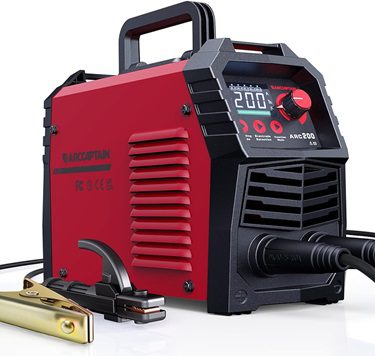
This welder works in Stick or Lift TIG mode, giving flexibility. It has adjustable hot start and arc force functions for smooth welding and prevents electrode sticking. Lightweight at 7.2 lbs, it’s easy to carry. It works with both 110V and 220V and has safety features like overcurrent protection. Its user-friendly design, portability, and safety features make it ideal for welding enthusiasts at any level
Best Features:
- Large LED display
- Synergic control
- IGBT inverter technology
- Hot start, arc force, and anti-stick features
- Dual voltage adaptability (110V/220V)
- Lightweight and portable design
- Suitable for stick and Lift TIG welding applications
Pros:
- User-friendly design
- Advanced welding features
- Built-in safety features
Cons:
- Limited amperage control for specific welding tasks.
Guide To Buying The Best Stick Welder (ARC Welder)
1. Power Output (Amps)
The amperage or the maximum current of the stick welder will let you know the thickness you can or cannot weld with them. Stick welders with the correct amperage rate can easily fuse any weldable metal of different gauge sections. A harder metal needs more amps per inch of thickness. For instance, most welding shop uses 70 – 90 amps for mild steel based on the particular material thickness.
So, it is advised to select a stick welder with the right amperage range based on the type of welding you need. For better performance, choose a welder with 20 to 50 amps more than the recommended rating to weld even higher or any unknown variables. A higher amperage welder will result in deeper penetration and let you weld thicker metals quickly and easily.
2. Input Voltage
Usually, welders can run on either single-phase power (110/120V input or 220/240V) or three-phase power (240V input). The single-phase is designed for standard household power and the three-phase is designed for industrial power to use heavy-duty machines.
The welder with 110/120V is an ideal option for hobbyists who simply plug in this welding machine to their standard household power outlet, whereas welders with 220/240V are perfect for professionals, who are quite powerful and require a proper power outlet. Some models can use both input voltages, which are called dual-voltage welders. Thus, the volt input or the electrical supply you can provide to a welder will determine the type of welder you choose.
A stick welder with 110V is a lighter, affordable, portable, and smaller option for those who only use a welder at home and do not weld steel thicker than 1/4-inch. It lets you carry it around any place and fit it easily in closets, under the car, and ducting. If you require to repair field plows, backhoe buckets, or semi-truck wheels, then a welder with 240-volt power to produce adequate current to weld thick pieces.
3. Inverter Vs. Transformer
Transformers and inverters are two types of welders based on the power source. Among these two, inverters are mostly used and are the preferred option by several welders.
Inverter:
A common type that is portable, energy-efficient, and lighter weight (15 – 20 pounds) makes it easy to carry around and consumes less storage space. They are meant for a more stable and smoother arc and also offer better control over the tool’s operation. Yet the inverters are a bit less robust than transformers, which makes the tool delicate in construction sites. In case, if it is of digital technology rather than analog, then you have to hire an expert service that costs extra rather than fixing them by yourself.
Transformer:
They come with solid designs (built-like tanks) that consume a lot of power and are meant to perform heavy-duty work. They are usually heavier options and take up a lot of space compared to inverters. Their initial cost is less yet they are built to last longer. Thus, it is considered the best stick for those who just perform occasional welding.
4. Duty Cycle
The time you can constantly weld with a given stick welder before it cools down is referred to as its duty cycle. The longer the duty cycle, the more efficiently it can accomplish your job. Make sure to purchase a welder with a high-duty cycle for longer welding periods to prevent overheating issues. This duty cycle is represented as a percentage or ratio.
For instance, a stick welder with a duty cycle of 30% means you can weld for 3 minutes before it cools down for 7 minutes. The duty cycle varies as per the output power settings of the stick welder. A welder with a higher amperage will result in a lower duty cycle. So, check the duty cycle and amperage of the stick welder before making its purchase.
If you intend to use a stick arc welder for home repair work or some other hobby welding tasks then a lower duty cycle is fine. However, for industrial applications or a professional welder, a higher duty cycle is required. The problem with a lower-duty cycle is you need to stop every 2 minutes.
5. Current Type
There are three choices available for the output current type to run the stick welder effectively. They are AC (alternating current), DC (direct current), and combination (both AC & DC).
Here is a detailed explanation that helps you in picking the correct option based on your welding requirement and the available current type.
- AC: This current type is mostly seen on entry-level or basic stick welder models, which are preferred by beginners or people who don’t find the DC option. It is widely used in situations where the metal gets magnetized by friction resulting in the arc blow.
- DC: A most common current type that lets you use the stick welder in many cases, except only on the magnetized metal case. It provides an arc that is easy to start, smooth, stable, and has less spatter. Also, it is an excellent option while performing overhead and vertical welding. Based on different welding characteristics, it offers two polarities – positive (high penetration with less deposition) and negative (less penetration with more deposition).
- Combination: This AC/DC welder type can be interchangeable with AC and DC output, as per your project/welding work requirement. However, DC output is used most frequently, yet if it has only AC output, then the welder tool gets switched to AC output to do your work.
6. Multi-Functional
A stick welder with additional functions/features is always the preferred and worthwhile option, especially for those who use the welder for various projects and need to switch between various functions at a low cost but not for those who use it only for stick welder.
There are some functions like plasma cutters, and easy and quick switching between different welding processes (TIG, MIG, or flux core). Besides this, some models offer control over amperage and voltage fluctuations, whereas most stick welders offer quick cooling systems to prevent the tool from overheating.
You can choose the stick welding machine by checking the required features for your welding purpose. It is a wise idea to invest in a multifunctional welder machine to accomplish your project requirements, as they offer simple modern technology solutions to perform arc welding efficiently.
7. Changing Electrodes
Unlike the TIG and MIG welding process, stick welding works on several metals by switching the stick to set the material while changing metals. But this takes a lot of time and requires skill. Go with a welder so that you can change the stick with ease but not complicate the task by wasting your time and effort.
Frequently Asked Questions
Ans: MIG welding is fast and simple but may not produce high-quality welds for critical seams. TIG welding offers clear distinctions between good and bad welds but is slower and more costly. Stick Arc welding stands out for being affordable, fast, and predictable. Stick welds are stronger with better metal penetration than MIG welds, requiring higher amperage.
Ans: The welding process utilizes an electrical current delivered from a welding power supply. This current could be either direct or alternating. It emerges from the welding power supply and passes through a gap present between the metal and the welding stick. At this point, the current will create an electric arc due to the difference in potential.
Ans: Yes, due to the versatility, the stick Arc welding can be used indoors and outdoors. It works efficiently for welding the majority of the joints and alloys.
Ans: Yes, using a stick Arc welder requires a high level of skill. This won’t be true for all welding processes, yet most of them require a high skill level. Especially, if you are a beginner/novice, then you have to practice before working on actual projects. Also, you get a clear idea of certain things like power source, duty cycle, technology or material used, portability, or protection features before making its purchase.
Ans: Sometimes, the welding rod might be bad due to rust-softened flux, or the formation of dried powder coating. In case, if you notice any bubbles on the weld, then it says the electrode or rod absorbs water and is not safe for use or welding.
Ans: You might get shocked by a welding machine, yet not electrocuted. Here it uses a controlled circuit of electricity to weld that might result in you getting shocked when welding in a wet environment or the welder itself gets damaged. Remember that voltage in these welding devices is too low which might hurt (if operated wrongly) but won’t kill the people.
Conclusion
The stick Arc welders are famous for their superior speed and predictability. They are extensively used in home and industrial welding applications. All the stick ARC welders discussed above have several unique functions and operations. Make sure you choose the ones that suit your requirements.
Here are our top recommendations for you
- YESWELDER Stick Welder offers strong performance with up to 205 amps, an easy-to-read LED display, and dual voltage input. Its compact size and portability make it useful for different welding tasks.
- DEKO Stick welder, has its high-quality performance, versatility, and user-friendly design. its advanced IGBT Inverter technology and ability to work with both 110V and 220V voltages, it offers precise control and dependable performance.
- The S7 Arc Welder Machine has advanced features like IGBT with Digital Display LCD and inverter technology. It’s portable and has a clear display, working on both 110V and 220V power.

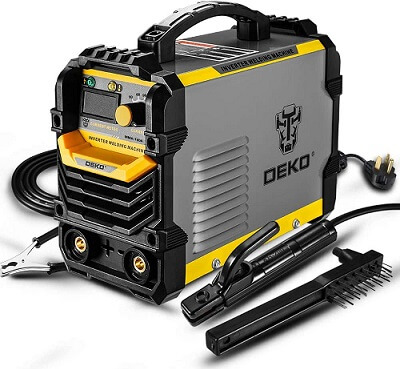
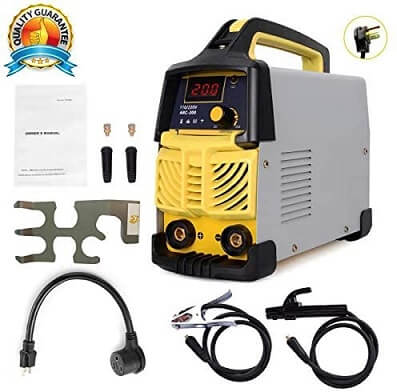
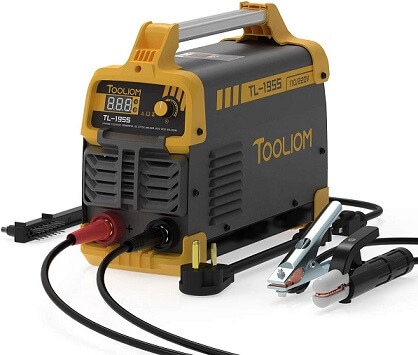
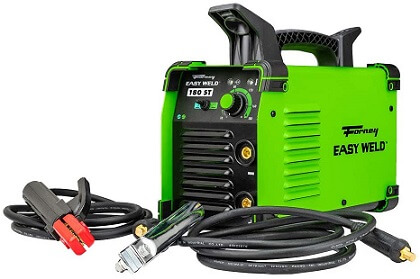

2 Responses
Thanks so much for the info.
Thank you for sharing informative and helpful details with us.